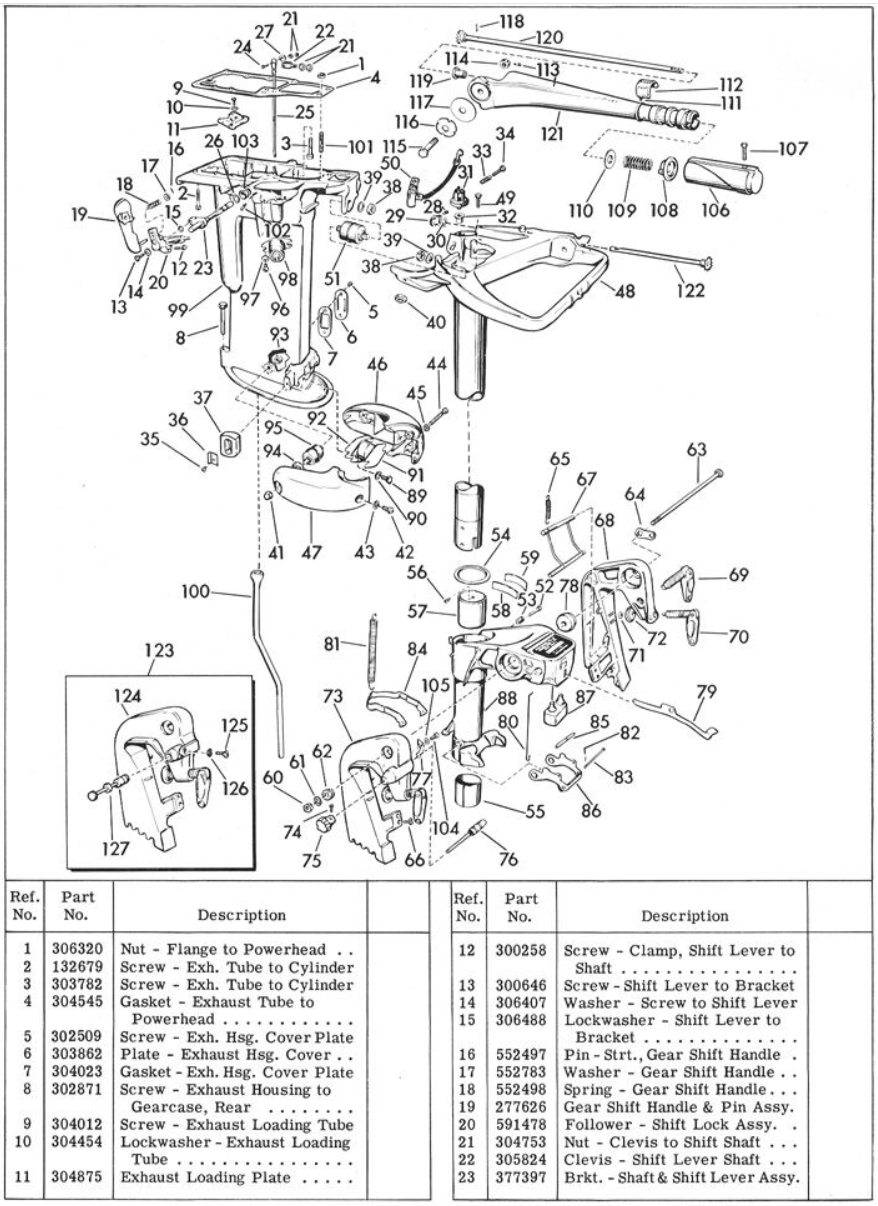Home › Forum › Ask A Member › Vacuum cutout switch question
- This topic has 14 replies, 8 voices, and was last updated 6 years, 6 months ago by
crosbyman.
-
AuthorPosts
-
October 26, 2017 at 10:38 pm #8545
Restoring a ’59 Gale 35HP……today’s question is about the vacuum cutout circuit:
I understand that this circuit is intended to kill the bottom cylinder if there’s an over-rev "runaway" situation, based on the increased crankcase vacuum activating the switch. OK…..I’m good with that.
Studying the schematic & verifying with my ohm meter, the circuit is based on the points being connected to a N.O. vacuum switch which, in turn, is series-wired through a mercury switch on the tiller gears. This mercury switch is closed, shorting the points to ground, when the throttle is turned up.
But here’s what I don’t get: If I hit a rock & shear my prop pin (causing a high rev condition), first thing I’m going to do is yank back on the throttle. Doing so tips the mercury switch to an "open" condition, which no longer connects the points to ground. i.e. disabling this circuit, re-enabling the bottom cylinder.
So what, exactly, is the point? Everyone I speak to tells me how critical this circuit is, but I can’t get a clear understanding of "why", insofar as pulling back on the throttle will defeat the circuit.
What am I missing?
October 27, 2017 at 3:39 am #66665October 27, 2017 at 11:03 am #66668I have this engine…and an identical ‘parts donor’ engine. Both are configured the same way…..and seem to match my service manual.
So if there’s something flawed in my understanding of the circuit, please shed some light. Saying that "something’s wrong" doesn’t really tell me anything…
October 27, 2017 at 11:23 am #66669The Mercury switch is only involved with the starting circuit. It prevents starting with the throttle advanced too far by interrupting the starter circuit. Has nothing to do with the ignition circuit.
October 27, 2017 at 12:18 pm #66672No…there’s 2 mercury switches on this model. One for the reason you cite. A second for the vacuum cutout switch.
I’m asking about the vacuum cutout sequence of operations. I’ll re-check everything with my ohm meter tonight and see if I have things misunderstood. If anyone can clarify things, that would be great….
October 27, 2017 at 2:40 pm #66675is the safety feature working currently defective or are you just in the process of figuring how it works ??
pulling back on the throttle means….. dropping the speed down ??
if so and if the mercury switch does becomes OPEN does it matter ? since the RPM will be dropped down to a safe level (no need to kill the bottom cyl by vacum switch grounding out the ignition cct. ??)
presumably being at a lower RPM this would cause the vacum switch to be OPEN itself (not grounded)
Sounds like the the lower cyl cut-out feature is the result of a logic AND condition requiring 2 things
HIGH VACUM FROM OVERREVING (ground) + HIGH THROTTLE POSITION (Mercury switch continuity to the ignition cct.)
OK done… now I will go read up on it
Joining AOMCI has priviledges 🙂
October 27, 2017 at 7:18 pm #66688Boat info site is down but if you have the file page 54-55 of the Johnson bible… it explains it for the RD RDE models
high vacum (by supplying a ground by contact closure) kills the bottom plug MOMENTARILY IF in neutral and RPM exceeds 2000 rpm or more
the other mercury switch is for starting purposes as explained above
Joining AOMCI has priviledges 🙂
October 27, 2017 at 8:11 pm #66691quote crosbyman:high vacum (by supplying a ground by contact closure) kills the bottom plug MOMENTARILY IF in neutral and RPM exceeds 2000 rpm or moreThat confirms what I thought!…
…which is why I asked: "what’s the point"? If I were to have a high-rev situation, first thing I’m going to do is yank back the throttle. (Isn’t that the normal first reaction?) Doing so defeats this safety circuit altogether, right?
Provided the person at the helm has the wherewithal to reduce RPMs in the event of a problem, doesn’t this circuit constitute "an ingenious solution to a non-existent problem"?
As I rebuild (and rewire) this engine from the ground up, is there some reason that this circuit really ought to be reconnected? I’m not seeing the need, but I’m completely open to meaningful input as to why it’s as essential as some say. Like I said, I’m told it’s a "must have", but nobody can explain why…
mn
October 27, 2017 at 8:20 pm #66692In neutral, at the max allowed throttle, on my RDs you can hear the thing working as a "chunk- a chunk-a" noise until you bring the throttle back down.
DaveOctober 27, 2017 at 8:23 pm #66693Just guessing here, but that device will do its job, long before a human can react….thus potentially saving a motor…
That is the way I have always looked at it…
http://www.richardsoutboardtools.com
classicomctools@gmail.com -
AuthorPosts
- You must be logged in to reply to this topic.




